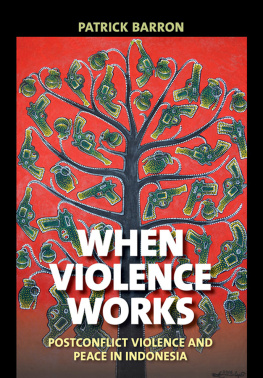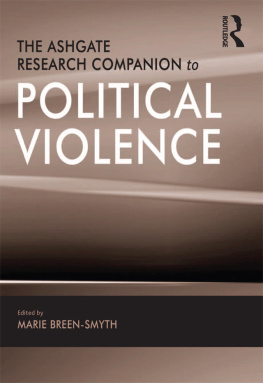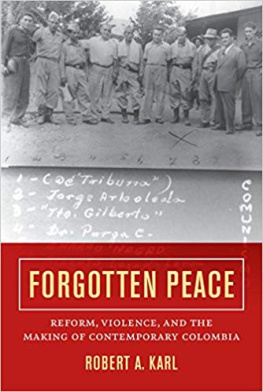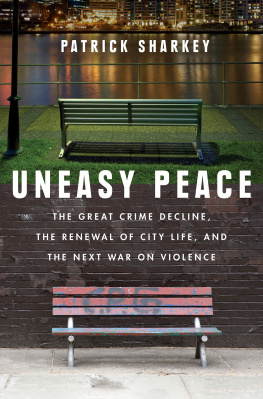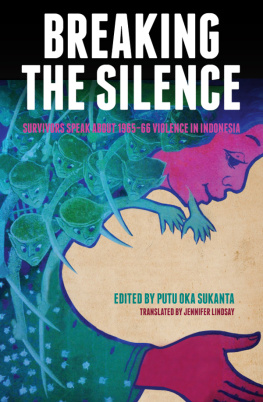Preface
In 2006, I was living and working in Aceh, tasked with developing programs for the World Bank that would support a recent peace agreement in the Indonesian province. After almost three decades of civil war, the first year of Acehs postconflict era had gone well. An international peace-monitoring mission had had relatively little to do and both the government and former rebel GAM leaders appeared committed to making the peace accord work. There was talk that the Indonesian president, Susilo Bambang Yudhoyono, could be up for a Nobel Peace Prize. Analysts were already declaring Aceh a rare story of peace-building success. I was also optimistic and saw much progress, but it was also clear that violence had not completely ceased. The monthly conflict monitoring updates we produced were starting to pick up incidents of many typesland conflicts, vigilante attacks, and most noticeably, a worrying upsurge in violent crime. It did not seem likely to me or others that a return to civil war was in the cards. But nor did Aceh appear to be as peaceful as some made out.
Trying to understand what was going on, I started to work my way through the academic and policy literature on why some peace settlements are successful while others are not. The books and papers I read sought to explain why civil wars often reoccurred after peace agreements or military victories had (temporarily) halted hostilities. But I found little that helped me understand why other forms of violence could emerge.
The ideas in the literature on the sources of postconflict violence also did not seem to fit with what I saw. If violence was the result of failed elite bargains, as some proposed, why was it occurring so frequently in Aceh even as leaders from both the rebel movement and the Indonesian government seemed so committed to the peace accord? If postconflict violence was the result of societal factors such as tense intergroup relations, another major focus in the literature, why was violence occurring even as surveys I commissioned were showing high levels of social cohesion? How could I square arguments that postconflict violence was a result of weak state capacity with the observed reality that Aceh was governed by a strong, and strengthening, Indonesian state? Existing theories were ill equipped to provide an explanation of what was happening in Aceh.
My interest in these questions strengthened as the first data came in from another project I was managing. Colleagues and I had been building a database of incidents of violence reported in local newspapers across Indonesia. Turn-of-the-century Indonesia had seen intercommunal conflicts in many provinces and the data provided an empirical picture of just how affected different regions had been. As I started to sift through the information on provinces such as Maluku and its close neighbor North Maluku, stark differences emerged. Both had seen horrific conflicts that killed thousands before peace agreements and fatigue had brought them to an end. Yet the data showed that Maluku had continued to see frequent outbursts of deadly violence while North Maluku had not. And many of the incidents in Maluku were having far greater destructive impact than that of the postconflict violence in Aceh. What could explain the differing postconflict trajectories of different Indonesian provinces?
This book seeks to answer three questions. What causes postconflict violence to occur in some places emerging from large-scale escalated violent conflict and not in others? Why do episodes of postconflict violence take different forms? And what causes violence to escalate into larger renewed and extended violent conflict?
In doing so, I develop a new theory of postconflict violence. Such violence is often not directly caused by failed elite bargains, dysfunctional intergroup relations, enduring grievances, or a lack of state capacity. Rather, it flows from the incentives that three sets of actorslocal elites, local violence specialists, and national eliteshave to use violence as a political or economic strategy. Violence is used when it workswhen it is beneficial, noncostly, and other opportunities for getting ahead do not exist. How postconflict resources are deployed, the degree to which those who use violence face sanctions, and the availability of peaceful means to achieve goals shape incentives and hence patterns of violence.
Where only local violence specialists support violence, the book finds, postconflict violence will take small-scale forms. Where local elites also support violence, escalation to larger forms of episodic violence tends to occur. In countries where the state has sufficient capacity, extended violent conflict occurs only where national elites linked to the state also have reason to use or allow violence to occur.
The arguments are based on a comparative analysis of the diverse postconflict experiences of Indonesian provinces and changes in national-level institutions and politics. But the same factors that explain variation in postconflict trajectories within Indonesia will also likely do so in other areas emerging from large-scale violence around the world. The ideas presented in this book have consequences for how we conceptualize, study, and understand the drivers of postconflict violence. They also have important implications for policymakers and practitioners working on and in postconflict areas.
The debts I have incurred writing this book are numerous. The ideas that underpin it have evolved slowly over the course of a decade living and working in Indonesia. Special thanks are due to Scott Guggenheim and Michael Woolcock who brought me to Indonesia and who have served as mentors extraordinaires since then. Other colleagues from my years at the World Bank in Jakarta and Aceh have been intellectual sparring partners as together we sought to understand the logic behind Indonesias violence: Muslahuddin Daud, Sana Jaffrey, Dave McRae, Adrian Morel, Blair Palmer, Sri Kusumastuti Rahayu, Didit Setiawan, Joanne Sharpe, Amy Sim, Andi Tama, Rob Wrobel, and Matt Zurstrassen. Adrian provided particularly helpful comments on the books case chapters. Thanks also to the two anonymous reviewers commissioned by Cornell University Press for their many helpful comments and to my editors at Cornell.
Other friends and colleagues, too many to list in full, have shaped my understanding of Indonesian violence, politics, and society. Thanks to Paul Adams, Aguswandi, Ed Aspinall, Vic Bottini, Raihana Diani, Rachael Diprose, Byron Good, Jesse Grayman, Suprayoga Hadi, Sandra Hamid, Sidney Jones (who also reviewed early write-ups of some of the chapters), Sri Kuntari, Karrie McLaughlin, Kharisma Nugroho, Ben Olken, Tom Pepinksy, Erman Rahman, Joanne Sharpe, Claire Smith, Matt Stephens, Sudarno Sumarto, Zulfan Tadjoeddin, Yuhki Tajima, Michael Vatikiotis, and Andrea Woodhouse. Dewi Fortuna Anwar provided useful comments on a draft paper outlining early findings.
The project really took flight during my time at the University of Oxford. Richard Caplan and Anke Hoeffler were a constant source of ideas, critical feedback, and encouragement. In Oxford, others provided useful comments on drafts or otherwise stimulated my thinking. Thanks to Nancy Bermeo, Christine Cheng, John Gledhill, Julien Labonne, Alex Scacco, and Maya Tudor. Gerry van Klinken also provided useful feedback.
Samuel Clark and Chris Wilson both went well beyond the duties of friendship by commenting on most of the chapters of the book. Conversations over coffees and beers with Sam and Chris also shaped my thinking at many points in the research and writing. While I did not incorporate all of their suggestions, and neither will agree with everything I have written, their testing questions about my findings and theoretical and methodological assumptions have made this a far stronger book than it would otherwise have been.

